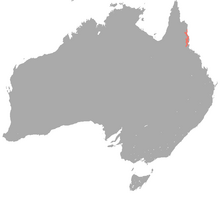Musky rat-kangaroo
| Musky rat-kangaroo | |
|---|---|
 |
|
| Scientific classification | |
| Kingdom: | Animalia |
| Phylum: | Chordata |
| Class: | Mammalia |
| Infraclass: | Marsupialia |
| Order: | Diprotodontia |
| Suborder: | Macropodiformes |
| Family: | Hypsiprymnodontidae |
| Genus: |
Hypsiprymnodon Ramsay, 1876 |
| Species: | H. moschatus |
| Binomial name | |
|
Hypsiprymnodon moschatus Ramsay, 1876 |
|
 |
|
| Musky rat-kangaroo range | |
The musky rat-kangaroo (Hypsiprymnodon moschatus) is a marsupial species found only in the rainforests of northeast Australia. Although some scientists place this species as a subfamily (Hypsiprymnodontinae) of the family Potoroidae, the most recent classification places it in the family Hypsiprymnodontidae with prehistoric rat-kangaroos.
The generic name combines the Ancient Greek (‘high’), prymnos (πρυμνός ‘hindmost’), and (‘teeth’). Its specific name, , is scientific Latin for ‘musk’.
It is the smallest macropod that is quadrupedal and only diurnal. The musky rat-kangaroo is about 21 to 34 cm long with a 6.5- to 12.3-cm-long hairless tail, weighs between 332 and 680 g, and eats fallen fruit and large seeds, as well as small invertebrates.
It moves by extending its body and then bringing both of its hind legs forward, and uses an opposable digit on the hind foot to climb trees.
The rat-kangaroo has a number of unusual traits that are seen as linking it to more primitive marsupial ancestors. For example, it has reptile-like scales on its feet and tail, engages in a more primitive hopping behavior than most of its kangaroo cousins, and 5 toes on each foot.
...
Wikipedia

